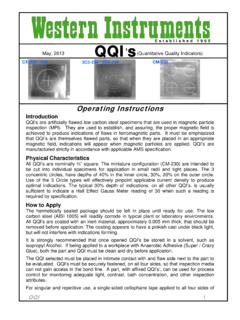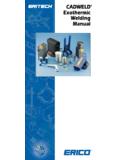Transcription of Weld Defects: Magnetism in pipe and its effects on Welding ...
1 1 Weld defects : Magnetism in pipe and its effects on Welding Western Instruments Sturgeon County, Alberta, Canada Magnetism and arc blow can cause Welding problems when Welding pipe particularly for pipelines. This has been extensively documented by a number of studies by people and organizations. The pipeline research committee of the American Gas Association had Proctor Inspection Consultants in Houston, Texas do investigations into this. A paper was published in March 1980 as a result of this work (Reference #1). The explanation of magnetic force, field generation associated with pipeline inspection pigs, geomagnetic fields and magnetic energy are covered in that document. There are various procedures suggested in this paper. Other investigations and analysis have been carried out and a number of the publications are listed in the references. An investigation by Jose Hiram Espina Hernandez and associates discuss the problems with residual Magnetism and arc blow which increases the incidents of defects .
2 I quote from their paper regarding arc blow: Residual Magnetism of the parts to be soldered effects DC arc Welding of pipelines during repair causing the arc to deviate, a phenomenon known as arc blow. Steel pipelines are huge ferromagnetic structures and can be magnetized by the earth s magnetic field .. (Reference #2) There is a wide variety of opinions expressed by others as to the maximum tolerable level of residual Magnetism and various ways of measuring this residual Magnetism . The National Shipbuilding Research program 1993, held a Ship Production Symposium sponsored by the Hampton Roads Section Society of Naval Architects & Marine Engineers (Reference #3). A System to Control Magnetic Arc Blow in Welding was designed by R. Brian Jones of Newport News Shipbuilding and in their investigations they found very high residual magnetic fields that, in some cases results in a welder not being able to strike an arc. They developed a system to help mitigate this and their device needs to be in position near where the Welding is being done.
3 They report that at about 40 gauss that the Welding arc can become unstable and in some cases even blown out. In the paper by Jose Hiram Espina Hernandez and associates (Reference #2) they express the opinion that residual Magnetism up to 40 gauss could be tolerated if certain procedures that they out line are followed but there is no report on the actual field usage of these proposed procedures. The 40 gauss residual Magnetism acceptable level for weld referred to in the literature citied appear to be based on balancing the residual Magnetism level in the adjacent pipe ends, but over 40 gauss demagnetizing is still required. Residual Magnetism is excess of 40 gauss is not uncommon in pipeline pipe. Figure #1 shows a 24 pipe being prepared for Welding . The solid steel pin hanging from the pipe indicates the residual magnetic field that made it impractical to weld and it was demagnetized with 3 pulses of the WDV-25PD Coil. The source of the magnetization was/is unknown and the residual Magnetism reported by the operator was 50 gauss, with the gauss meter 2ft from the end of the pipe.
4 This is an unusually high level of residual Magnetism , and with no explanation of how this was induced 2 Figure #1 24 magnetized pipe, Fort McMurray, Alberta Causes of Residual Magnetism : There are many causes of residual Magnetism in pipes, such as magnetic fields induced during pipe manufacturing and coating processes. Other factors are handling of pipe using, however transporting of pipes, particularly in and around overhead power lines is reported by operators to be affected to a greater degree. It has been reported by some researchers that the movement of pipe with respect to the earth s magnetic field can induce residual Magnetism in pipes. To our knowledge we arem not aware of definitive studies to try to identify and differentiate between the various causes for residual Magnetism in pipes. Flow of fluid in pipe and pipelines are reported to magnetize them to a high level. It would be a very complex study to try to deal with the prevention of residual Magnetism in pipes and it is not considered a practical approach.
5 Field measurements of pipe, both along construction right of ways and in storage have been made and found that residual Magnetism can vary widely. The lowest residual Magnetism found in our investigations was in the order of about 2 gauss but we also found residual Magnetism in excess of 50 gauss which is well beyond field weld-ability. There are varying opinions as to the maximum allowable residual Magnetism for pipe welder s capability. It has also been found that the level of residual Magnetism in pipes that are strung along a right of way vary significantly from pipe to pipe and location to location and around the circumference (Figure #2). It is our conclusion and by others with direct experience with pipe Welding that it is not considered practical to prevent the magnetization of pipes in the normal course of pipe manufacturing, coating, handling, stringing etc and the most desirable situation is to be able to demagnetize the pipe ahead of the alignment and Welding process.
6 Mr. Ian Kopp (Acknowledgment # 1) and Tim Marten (Acknowledgement #2) feel that the maximum allowable residual Magnetism is 5 to 7 gauss to prevent the formation of defects due to arc blow. The experience of Ian Kopp and Tim Marten with cable wrap type of devices for dealing with residual Magnetism is that it is time consuming and interferes with pipe Welding operations. Further it is problematical 3 to obtain the desirable maximum level is 5 7 gauss. It can be assumed that the tolerances of pipe ends can be better dealt with by welders, if the pipe ends are demagnetized. The normal variations within specified tolerances, such as land width, inside diameter variations, roundness etc is routinely dealt with by welders. However, residual Magnetism makes it much more difficult for the welder. Figure #2 Circumference of pipe, Kevin King, Fatigue Masters Inspection Figure #3 - 20 pipe, 10 Gauss, 6 from end of pipe on pipeline right of way Figure 2 Figure 3 4 Measurement of Residual Magnetism : The most widely known technology for doing this are electronic devices based on the Hall Effect principle (micro measurements).
7 These devices are generally used in various studies that have been published regarding residual Magnetism and arc blow. It is often assumed that digital devices are better however, in this application they are more difficult to use. These devices require knowledge and skill to use them effectively. Purpose built analog magnetometers shown in Figures #3 and #4 have been developed to make it far easier and practical to determine the effective residual Magnetism under field conditions (macro measurement). These units are readily available in the ranges of 10-0-10, 20-0-20 and 50-0-50 Gauss and are available from several manufactures. However, it is important that the devices used are linear and calibrated in a uniform field device. Their range can be readily checked in the field with a hand held device (Figure #4) as to whether they are within the range for which they have been calibrated to.
8 Typically, the 10-0-10 or 20-0-20 gauss meters are used to check a pipe end. However, if these analog magnetometers are placed on a pipe end, their internal movement can be damaged by strong magnetic fields, such as during a Reversing and Reducing Demagnetization procedure. These simple Analog Gauss Meter are very effective and only take minutes to train an operator to use these appropriately to obtain consistent and repeatable results. Of course the measurements must be made at the pipe end that has been prepared for Welding . These devices are referred to, including their use, in the demagnetization procedure developed by Mr. Kevin King of Fatigue Masters Inspection Ltd (Acknowledgement #3). The electronic HALL Effect Magnetometers are useful for investigative work where they are used by highly trained and experienced technical personnel. Hall Effect magnetic field measurement and their use under actual field operating conditions is difficult and the information provided is also difficult to interpret and are not practical for field use.
9 Figure #4 10-0-10 Gauss Meter & Verification Fixture 5 Techniques and Equipment for Demagnetization: There are various types of demagnetization devices, and these are summarized in T H. Hill associates DS-1, fourth addition volume 3 Drill stem Inspection (Reference #4) procedure. The bulk of this procedure and summary deals with the use of various AC (Alternating Current) devices to deal with residual Magnetism . It is a good summary of these devices and techniques but in , under procedures, it states demagnetization using DC equipment is recommended for larger components as AC fields lack penetration to remove internal residual magnetization and states: - Starting current amperage will be equal to or greater than the amperage used for magnetizing - Component is subjected to consecutive steps of reverse and reduced direct current magnetization until the desired level is achieved. - Each step down must last one second in order to allow the field in the part to reach a steady state.
10 The Hill procedure did not anticipate the Western Instruments WD-Series of demagnetization equipment. The DC principle that is referred to has been known for a long time however, the equipment and procedures have been difficult to implement in a practical form. Western Instruments WDV coil development makes it possible to effectively demagnetize pipes under field conditions. The pulsed DC current and its control makes it practical to reduce the residual Magnetism to near zero (earths magnetic field in this area is in the range of gauss). The nature of these DC pulses not only demagnetizes the ends of the pipe, but the ends stay demagnetized, typically for days. Tests on 10 pipe were carried out for 10 days using both Analog and Hall Effect Magnetometers with no measureable re-magnetization and this is because the demagnetization process is effective through the full thickness of the pipe wall, without any skin effect as with AC methods.






